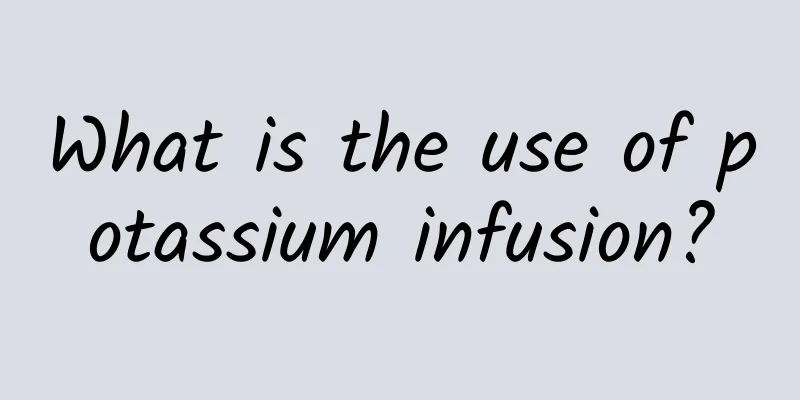What is the use of potassium infusion?

|
As we all know, our bodies actually need some trace elements, or minerals. Although the body cannot synthesize these minerals on its own, they are of great help to our health. Some friends have found that potassium is infused during intravenous infusion. What's the use of this? In fact, for some patients who are deficient in potassium, they will experience symptoms such as lack of energy and paralysis of the limbs, so they need to supplement potassium in time. Potassium chloride infusion is a potassium supplement through the vein, which stimulates blood vessels, so it is recommended to slow down the speed. If too much potassium is supplemented too quickly and causes hyperkalemia, there is a risk of cardiac arrest, so it is recommended to use the medication under the advice of a doctor. It can be taken orally, but it will also irritate the stomach, so you still have to decide which method of supplementation is suitable based on your physical condition! Potassium cannot be synthesized in the human body. The potassium concentration in human serum is only 3.5~5.5mmol/L, but it is necessary for life activities. The main function of potassium in the human body is to maintain acid-base balance, participate in energy metabolism and maintain normal neuromuscular function. When the body lacks potassium, it will cause general weakness, fatigue, weakened heartbeat, dizziness, and severe potassium deficiency can also lead to respiratory muscle paralysis and death. In addition, low potassium can slow down gastrointestinal motility, leading to intestinal paralysis, aggravating anorexia, and causing symptoms such as nausea, vomiting, and abdominal distension. Clinical medical data also proves that people who suffer from heatstroke all have low blood potassium levels. When potassium is deficient, the clinical symptoms are often masked by the primary disease. Potassium deficiency reduces neuromuscular excitability, causes general weakness, and reduced reaction ability. In severe cases, it may lead to flaccid paralysis and difficulty breathing. It also causes digestive tract dysfunction, with anorexia, nausea, vomiting, and bloating. In severe cases, there may be intestinal paralysis and intestinal obstruction. Potassium deficiency increases myocardial irritability and causes arrhythmias, atrioventricular conduction block, and even atrial and ventricular fibrillation. Potassium deficiency is called periodic paralysis in Western medicine. Traditional Chinese medicine calls it impotence. Clinical manifestations: mental depression. Fatigue. Muscle soreness. Paralysis of all four limbs. In severe cases, it can cause paralysis of the respiratory muscles, leading to difficulty breathing and death. 1. Medical history and symptoms: It is more common in young and middle-aged men, and may have a family history. It is often triggered by cold, a full meal, or fatigue. It often develops acutely in the middle of the night, early in the morning, or after a nap, and may recur with flaccid paralysis of the limbs as the main manifestation. 2. Physical examination findings: 1. Flaccid paralysis of the limbs of varying degrees, usually starting from the lower limbs, with more severe proximal parts. In severe cases, the respiratory muscles are affected, and there may be muscle pain but no sensory impairment. Most patients recover within a few hours to one or two days, and some may recover within a week. 2. When the myocardium is affected, bradycardia, ventricular premature beats, increased blood pressure, etc. may occur. 3. Hypokalemia caused by hysteria, Guillain-Barré syndrome, hyperthyroidism, hyperaldosteronism, cottony alcohol poisoning, renal tubular acidosis, etc. should be excluded. 3. Auxiliary examination: During the attack, blood potassium decreases and the electrocardiogram shows hypokalemic changes. The response of paralyzed muscles to direct current stimulation is weakened and absent. 【treat】 1. Attack period: You can take 4-10g of potassium chloride orally at a time (0.2g/kg for children). After the condition improves, continue to take 1-2g of potassium chloride, 3-4 times/d, and stop taking it after full recovery. For patients with more serious conditions, add 30 ml of 10% potassium chloride to 1000 ml of normal saline and slowly drip it. The total amount of potassium chloride in 24 hours should not exceed 8 g. For those with breathing difficulties, give oxygen, suction sputum, and perform artificial respiration if necessary. Patients with arrhythmia were given 30 ml of 10% potassium chloride and 10 u of insulin added to 1000 ml of 5% glucose solution and slowly dripped intravenously. Digitalis drugs are prohibited because of the high risk of poisoning. 2. Intermission period: Avoid various inducements such as overeating, eating large amounts of high-sugar foods, excessive fatigue, etc. If necessary, take 10% potassium chloride 10 ml orally 3 times a day. 3. Some patients still have arrhythmia during the intervals and may often die suddenly due to ventricular tachycardia. Be vigilant and take active measures to prevent and control it. |
<<: How to distinguish eczema from ringworm with naked eyes
>>: Which is better, ceramic or metal braces?
Recommend
What are the signs of purpura recurrence?
Allergic purpura is a common disease, and its cha...
What causes peeling on children's hands?
There are many reasons for the peeling of childre...
The best way to treat premature ejaculation
The problem of premature ejaculation troubles man...
The principle of nano seamless double eyelid surgery
Nano-invisible double eyelid surgery is a common ...
What is the difference between conjunctivitis and keratitis?
Some diseases are often confused because they hav...
What are the early symptoms of dandruff?
Psoriasis is a relatively common skin disease. It...
Symptoms of Yin Deficiency and Lung Dryness
Yin deficiency and lung dryness is a term in trad...
Causes of Cardiogenic Shock
Shock is a sudden symptom that we often hear abou...
Thyroid inflammation
Thyroiditis is a common disease. Thyroiditis is c...
How to reduce swelling after double eyelid surgery
Some women have small eyes due to congenital or a...
My hands are always itchy with blisters
People who always have blisters on their hands of...
What are the symptoms of panlong herpes?
Herpes zoster, also known as shingles, is a relat...
Can I exercise if I have synovitis?
The synovium is a connective tissue attached to t...
Trichomoniasis
Most female friends are aware of some gynecologic...
Is it good for children to take globulin?
People grow up eating grains, so it is inevitable...









